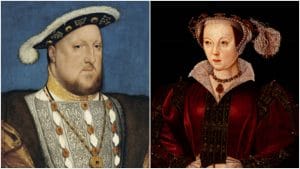 On this day in history, 12th July 1543, King Henry VIII married his sixth and final wife, Catherine Parr, Lady Latimer, widow of John Neville, 3rd Baron Latimer of Snape in Yorkshire, in the Queen’s Closet at Hampton Court Palace.
On this day in history, 12th July 1543, King Henry VIII married his sixth and final wife, Catherine Parr, Lady Latimer, widow of John Neville, 3rd Baron Latimer of Snape in Yorkshire, in the Queen’s Closet at Hampton Court Palace.
The chroniclers only mention the marriage in passing, giving few details:
“In this yere, the Kyng maryed Ladye Katherin par widow, late wyfe to the Lorde Latymer, at Hampton Court.”1
“This yeare, the 12 of Julye, Lady Katherine, late wyfe of the Lord Latimer, lately departed, and sister of the Lord Parre, was proclaymed Quene and marryed to the Kinges Majestye at Hampton Courte.”2
“The twelfe of Julie, at Hampton court, the king maried the ladie Katharine Par, widow, late wife vnto the lord Latimer deceased, and then she was nominated queene, and so proclaimed.”3
However, further details are given in the notarial attestation by Richard Watkins, the King’s prothonotary, in Letters & Papers:
“Notarial instrument witnessing that, on 12 July 1543, 35 Hen. VIII., in an upper oratory called “the Quynes Pryevey closet” within the honor of Hampton Court, Westm. dioc., in presence of the noble and gentle persons named at the foot of this instrument and of me, Ric. Watkins, the King’s prothonotary, the King and lady Katharine Latymer alias Parr being met there for the purpose of solemnising matrimony between them, Stephen bp. of Winchester proclaimed in English (speech given in Latin) that they were met to join in marriage the said King and Lady Katharine, and if anyone knew any impediment thereto he should declare it. The licence for the marriage without publication of banns, sealed by Thos. abp. of Canterbury and dated 10 July 1543, being then brought in, and none opposing but all applauding the marriage, the said bp. of Winchester put the questions (recited) to which the King, hilari vultu, replied “Yea” and the lady Katharine also replied that it was her wish; and then the King taking her right hand, repeated after the Bishop the words, “I, Henry, take thee, Katharine, to my wedded wife, to have and to hold from this day forward, for better for worse, for richer for poorer, in sickness and in health, till death us depart, and thereto I plight thee my troth.” Then, releasing and again clasping hands, the lady Katharine likewise said “I, Katharine, take thee Henry to my wedded husband, to have and to hold from this day forward, for better for worse, for richer for poorer, in sickness and in health, to be bonayr and buxome in bed and at board, till death us depart, and thereto I plight unto thee my troth.” The putting on of the wedding ring and proffer of gold and silver (described) followed; and the Bishop, after prayer, pronounced a benediction. The King then commanded the prothonotary to make a public instrument of the premises. Present : John lord Russell, K.G., keeper of the Privy Seal, Sir Ant. Browne, K.G., captain of the King’s pensioners, and Thos. Henage, Edw. Seymer, Hen. Knyvet, Ric. Long, Thos. Darcy, Edw. Beynton, and Thos. Speke, knights, and Ant. Denny and Wm. Herbert, esquires, also the ladies Mary and Elizabeth the King’s children, Margaret Douglas his niece, Katharine duchess of Suffolk, Anne countess of Hertford, and Joan lady Dudley, and Anne Herbert.”4
As you can see, the King’s daughters, Mary and Elizabeth, were present at the wedding.
You can read more about Catherine Parr in the following articles:
- Was Katherine Parr a feminist?
- 25 April 1544 – Queen Catherine Parr’s first work is published
- The Catherine Parr Bio page
- Catherine Parr – The Old Nursemaid?
- Catherine Parr in Danger, an article by Elizabeth Norton
- Last But Not Least: The Enduring Fascination of Catherine Parr, an article by Linda Porter
- Catherine Parr – The One Who Got Away
- The Death of Catherine Parr
- The Mystery of Mary Seymour Solved?
- 30 August 1548 – Catherine Parr, Queen Dowager, Gives Birth to a Daughter
Notes and Sources
- Hall, Edward (1809) Hall’s chronicle: containing the history of England, during the reign of Henry the Fourth, and the succeeding monarchs, to the end of the reign of Henry the Eighth, in which are particularly described the manners and customs of those periods. Carefully collated with the editions of 1548 and 1550, J Johnson, p. 858.
- Wriothesley, Charles (1875) A chronicle of England during the reigns of the Tudors, from A.D. 1485 to 1559 Volume 1, Camden Society, p. 143.
- Holinshed, Raphael (1807) Chronicles of England, Scotland and Ireland, Volume III, J Johnson, p. 832.
- Letters and Papers, Foreign and Domestic, Henry VIII, Volume 18 Part 1, January-July 1543, 873.